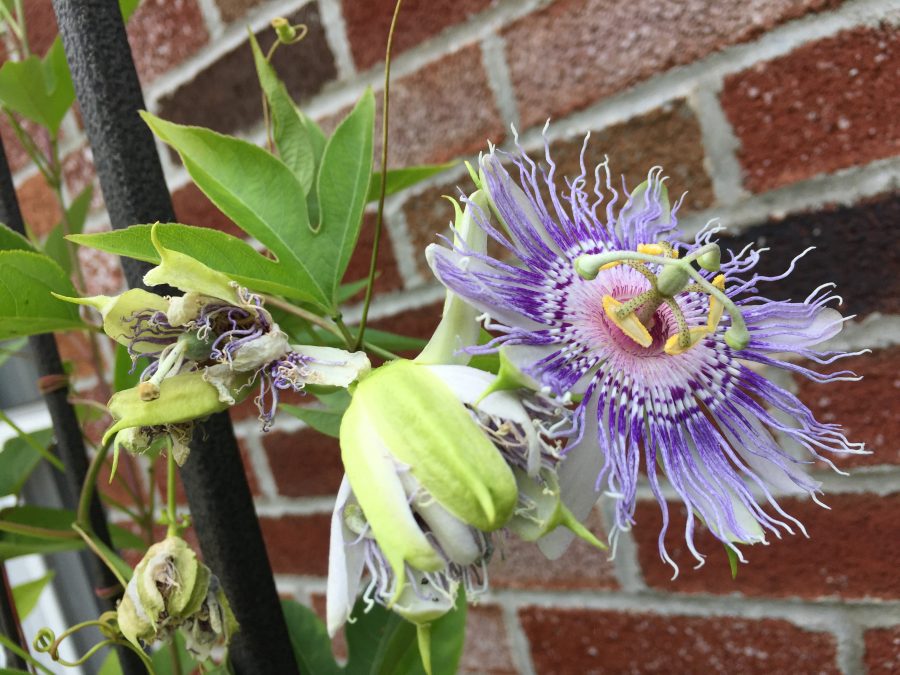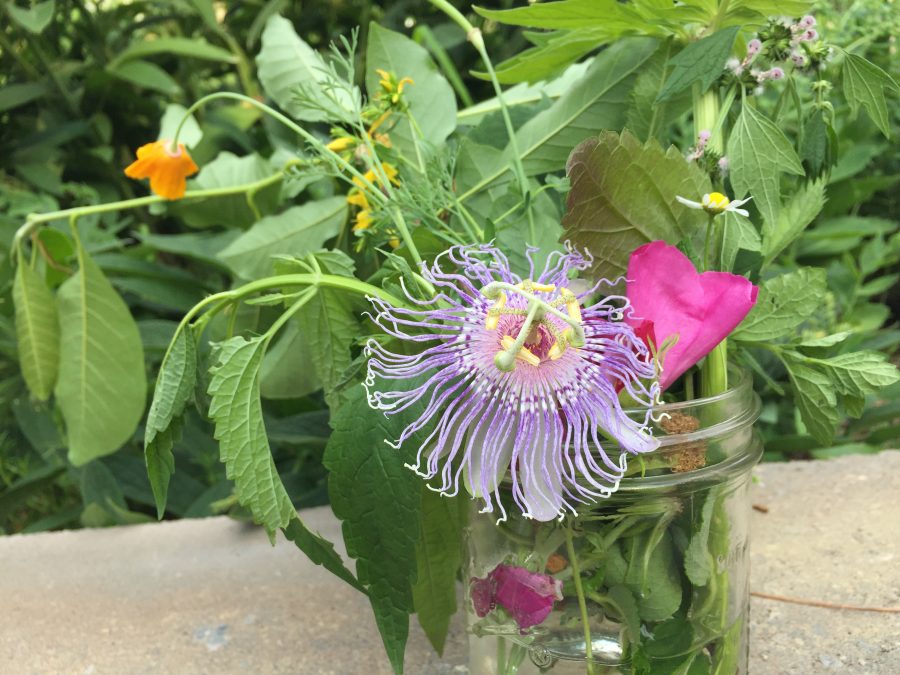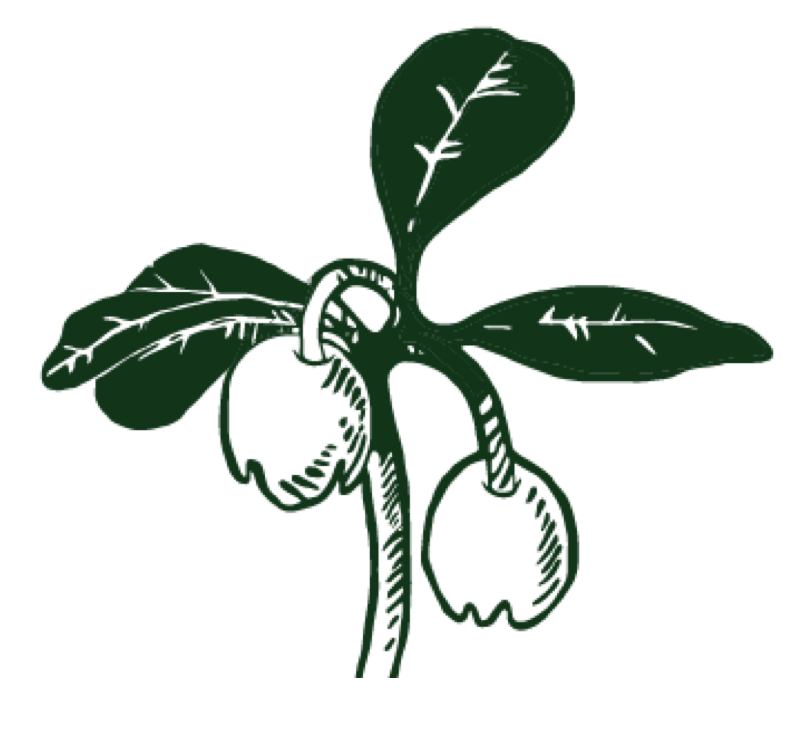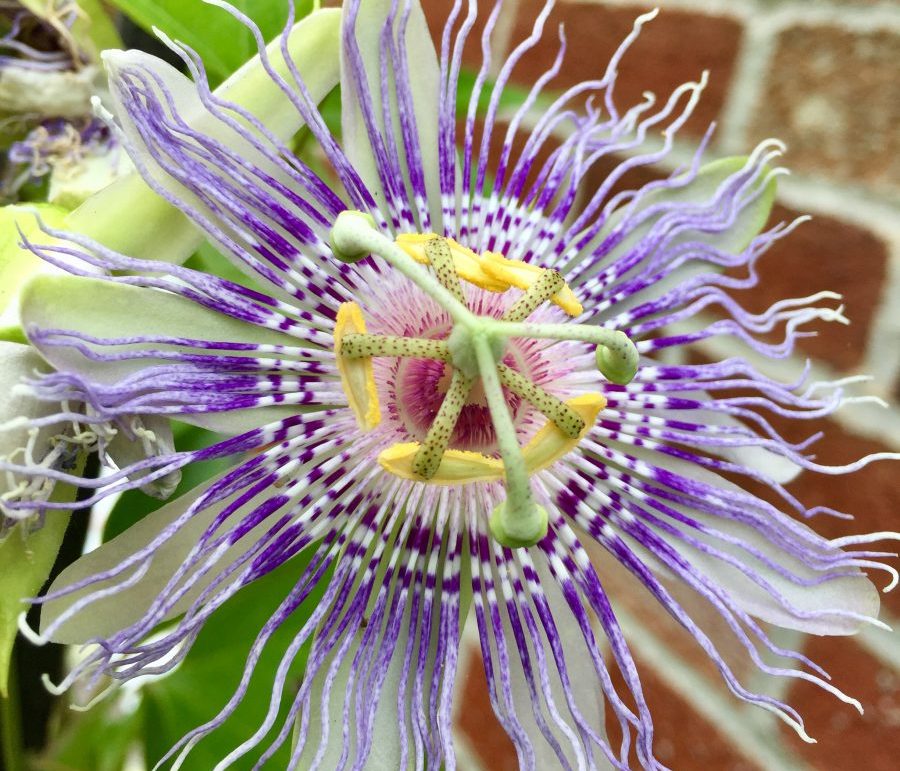Oh my goodness, just look at those gorgeous, otherwordly flowers! The feeling you get gazing on them is a good indicator of what this plant does in the body: Zen, relaxation, sedation, deep peace, hypnotic, bringing everything down a notch and into a mellow, happy place.
Growing Passionflower
Our medicinal passionflower grows wild, native to the American Southeastern states, such as Florida. The rambling vine sends up shoots, grabs with little tendrils climbing its way across the landscape where it can get moderately invasive. Here in New Hampshire, we're on the outermost edge of its range (which is iffy in zone 6). You might be able to grow it in some of our warmer pockets of New England in a protected spot year-round, but more often we need to grow it in pots to come indoors in winter. Mine has not been particularly happy with the move in/outdoors, loosing many leaves and stems, but then it reboots and new shoots grow beautifully from the roots.
Passionflower likes it warm with moderately good soil and moisture, part to full sun. It will need something to climb - a trellis, nearby plants, fence, string. The tendrils are thin and small, so it might need to be trained or to have something thin like string to help guide it. When happy, it can reach good distances on relatively thin stems. It does not appear to be as robust and "tear your house apart" as other vines like wisteria, thankfully.
I'm overjoyed that this is the first year I have successfully grown passionflower into a second season, with my first-ever blooms appearing this week (yippie!). Those I planted in the ground previously barely grew and did not survive winter. The first passionflower I bought from one of my (usually) reputable NE growers turned out to be a different species - P. caerulea - which is gorgeous with the most amazing sweet-scented flowers, growing abundantly both inside and outside the house. But that species is, alas, not medicinal or safe.

Will the Real Passionflower Please Stand Up?
With some plants, you can use various species within the genus interchangeably, but that is not the case for Passionflower (Passiflora spp.). Medicinal activity, fruit edibility, and safety vary widely from species to species, with some being moderately toxic. Add to that more than 400 Passiflora species and countless horticultural varieties and hybrids. If you want to grow passionflower for medicinal use, I recommend getting it by mail from a reputable grower like Strictly Medicinal Seeds or Companion Plants. I've ordered live potted plants from both companies and have had young plants arrive in great shape when ordered/shipped mid-May priority mail (so it's not crazy expensive but also not too hot or cold in transit across the country). Your typical nurseries cannot be trusted.
Identifying Passiflora incarnata
Unfortunately there's no perfect system of checkmarks to say for sure that you have P. incarnata because the Passiflora genus is vast (more than 400 known) has been widely tinkered with by horticulturists with many varieties and hybrids, so this check list does not guarantee that it's the medicinal P. incarnata, but it does suggest it is and helps rule out other common species. The two most commonly encountered species besides P. incarnata are P. edulis (which is grown for the edible passionfruit fruits), which is hard to distinguish from P. incarnata, and P. caerulea, which is more ornamental with sweet-smelling flowers.
- Petals are white
- Crown/corona (those frilly parts) is purple or pink, approximately similar in length or longer than the petals (in P. caerulea they tend to be shorter than the petals)
- Leaves have three lobes (P. caerulea has 5)
- Mature fruit is yellow (the common edible passionfruit species P. edulis is deep purple)
Botanical key source: Manual of Cultivated Plants by L. H. Bailey, published in the 1920s and available for free online at https://archive.org/details/manualofcultiva00bail
Using Passionflower Medicinally
Passionflower aerial parts - leaves, vines, tendrils, flowers - is one of my favorite herbs for sleep and sedation the nervous system. Enjoy it fresh or dry, as tea, tincture, capsule, whatever. It’s often quite effective and blends well with other herbs. You can start with a low dose to gauge how sedating it is for you. Perhaps 20 to 30 drops, 1.5 to 1 ml of the tincture, 1/2 to 1 teaspoon of the dry herb in tea. If you're not growing your own, many reputable sources for the dried herb exist - one of my personal favorites is Mountain Rose Herbs due to their quality and identity testing. I have made great tinctures from MRH dried passionflower using the 1:5 dry herb in 50-60% alcohol method as described in my books and here.
Sleepy Sedative
The main way I use passionflower is for sleep. The few studies that have been done showed much more impressive results than valerian. And, in one study, a combination formula that included passionflower worked as well as zolpidem (Ambien), decreasing the time it took to fall asleep, the number of nighttime awakenings, and the insomnia seventy index (Source: full text at PMC3608291). Just a teaspoon in tea also worked well (Source: PMID: 21294203, full text here). Passionflower takes the nervous system down a notch with sedative and mild hypnotic activity. It's excellent for insomnia due to mind chatter, stress, or anxiety.
Maria's Sleep Tea: I make a really awesome sleep tea using equal parts (1/2 teaspoon each) passionflower (the heavy hitter), skullcap, lemon balm, and (for flavor) spearmint with a good dollop of honey, brewed small and strong for 15 to 20 minutes in a small teacup - you don't want to have to get up in the middle of the night to pee! Get my Sleep Tea recipe and watch a video here. This is safe for kids to elders, but it is quite potent, so try a little out first, sipping just before bedtime. (Note that while I love Mountain Rose for passionflower, and you can get good dried spearmint almost anywhere, I'm most picky about sourcing dried lemon balm and skullcap due to quality concerns and the need for fresh and very careful handling - these I prefer getting direct from an American organically cultivated farm, harvested within the year, such as Terra Basics in New Hampshire or Zack Woods Herb Farm or Foster Farm Botanicals in Vermont. If you grow your own, make sure your skullcap has been correctly identified and is in flower before harvesting (ID tips here from 7Song). Lemon balm and skullcap both turn black easily while drying - be sure to dry on in a thin layer with good airflow on low heat. They're best used within one year of harvesting.)
Sleep Tincture Blend: I most often blend 50% passionflower with 25% skullcap (Scutellaria lateriflora) and 25% magnolia bark (any Magnolia species, I use a kobus-stellata cross) tinctures to take 1 to 3 ml before bed, especially nice for those folks who wake up in the middle of the night or wee hours in panic mode (magnolia bark really helps here for that!). But feel free to experiment - it blends well with many herbs.
Anxiety, Agitation & Fire
Passionflower's sedative nature can also help with reducing anxiety and panic as well as agitation, anger, and fire. Cool and calm is the mantra of passionflower. However, some people might find it too sedating during the day (like me! oh my goodness, I can't even function!) while others (like my fiery friend who experiences regular panic-anxiety, burns hot like a furnace, and often wants to rip people's heads off) adore it as a go-to plant day or night.
Michael Moore recommended it for adults, teens, and children who get angry and don’t want to calm down with generally “pissy” dispositions. (It’s one of the herbs he used himself, since he fit this profile.) He also recommended it for people who become agitated and stressed switching from blue collar, physical jobs to white collar desk jobs.
But, if someone is already sluggish or depressed in nature, this plant might exacerbate that, too. In these situations, you might be able to use smaller amounts of passionflower in formula with other herbs that are calming but not so sedating - motherwort, lemon balm, milky oat seed, holy basil, and ashwagandha are great options - or you may just skip passionflower all together during the day.
Additional Uses
Passionflower's calming, cooling "chillax" activity extends to many body systems. It's a good consideration in stress-related hypertension formulas (alongside more overt hypotensive herbs like motherwort, hawthorn, linden, hibiscus... assuming this is not too sedating for someone during the day). It's also useful in respiratory issues like asthma that are triggered or exacerbated by stress, anxiety, trauma, or grief. Michael Moore used to find the trio of passionflower tea (to calm), echinacea tincture (to support immune health), and horehound capsules (to thin mucus, expectorate and open the lungs) profoundly useful as daily remedies or at early signs to reduce the severity of progression of asthma symptoms. Note that this was not for acute asthma attacks that warrant the use of an inhaler or trip to the ER but to use regularly before it got that bad to hopefully avert the progression to an acute state. Also consider it in stress- or anxiety-provoked digestive formulas such as irritable bowel syndrome alongside more overt GI herbs such as peppermint, fennel, cardamom, chamomile, catnip, and/or marshmallow.
Cautions
Passionflower is generally quite safe; however, you will want to ensure that you've got correctly identified and also good quality plant material. As mentioned, other Passiflora species may actually be toxic or harmful, and it is often misidentified in plant nurseries. Also, if not properly handled, the dried herb can degrade to brown dust with mediocre potency. Good dried passionflower is light to medium green in color, not light brown.
The sedative effects of passionflower can vary in strength from person to person, so start low (and at night or on a relaxing day) to see your response and slowly work your dose up. It can synergize sedative drugs (sleep, antidepressant, anti-anxiety, some pain meds), making them even more sedating. This might be good (less anxious and sleeping better) or not so great (too tired to work, waking up groggy) to dangerous (falling asleep at the wheel, making a mistake with heavy machinery, and in extreme cases in high doses, decreased respiration, blood pressure, or heart rate). Also, some people with sluggish depression may find that regular use of passionflower triggers or increases the depression and melancholy. Start low and listen to your body!
It's also worth noting that if you're not sleeping well because you have sleep apnea or sleep hypoxia, you don't need sleep herbs, you need more oxygen. Your body is waking you up because you're in danger. Common signs of these types of sleep issues include snoring, waking up gasping for breath, or your bed partner has witnessed periods where you stop breathing in your sleep. See a sleep specialist. Common approaches to sleep apnea include CPAP machines, mouth pieces, sleeping on side instead of your back (if it's mild apnea), losing weight, and addressing any triggers/irritants (alcohol consumption, allergies, food allergies, inflammation). Herbs are not the solution, at least not directly. The oxygen deprivation associated with apnea and hypoxia can have many detrimental effects including shorter lifespan, more systemic inflammation, blood sugar issues, heart disease, and cognitive decline, so deal with it directly.

Learn More
- Sleep Better Naturally blog post of mine, discussing a variety of sleep herbs
- Juliet Blankespoor of the Chestnut School of Herbal Medicine has several nice articles on passionflower on her blog with gorgeous photos including growing tips
- HerbRally Passionflower Monograph by Krystal Thompson
- If you're an American Herbalist Guild member, the Audio Visual Resources page has a nice talk "Sleep Herbs Made Easy" by Daniel Gagnon discussing specific indications of common sleep herbs
- Passionflower is covered in many herb books.
Clinical herbalist Maria Noël Groves sees clients and teaches classes at Wintergreen Botanicals Herbal Clinic & Education Center in Allenstown, New Hampshire.
The statements made on this blog have not been evaluated by the FDA and are not intended to diagnose, prescribe, recommend, or offer medical advice. Please see your health care practitioner for help regarding choices and to avoid herb-drug interactions.

